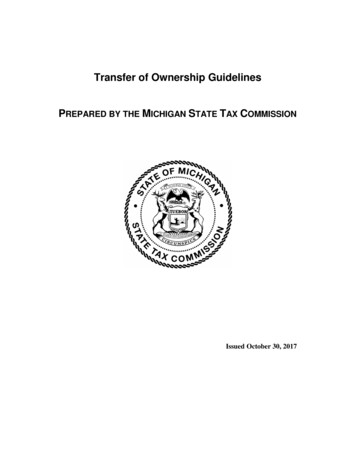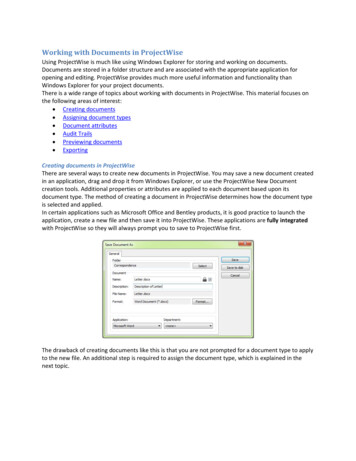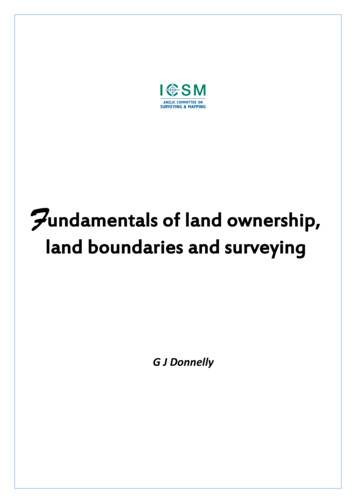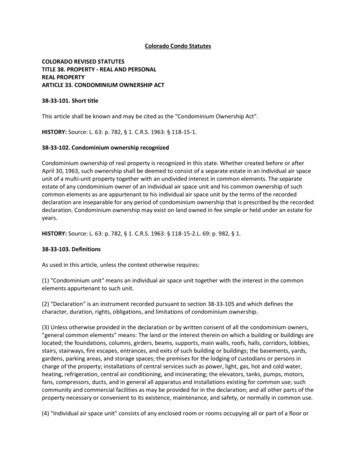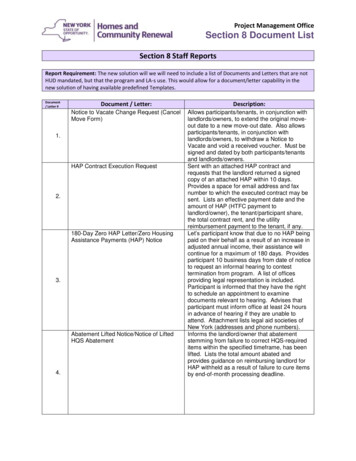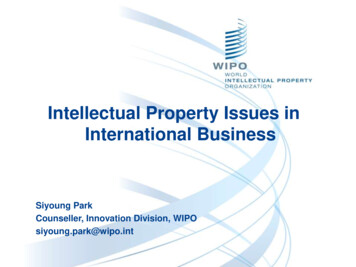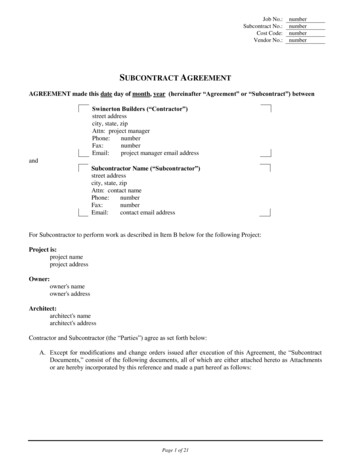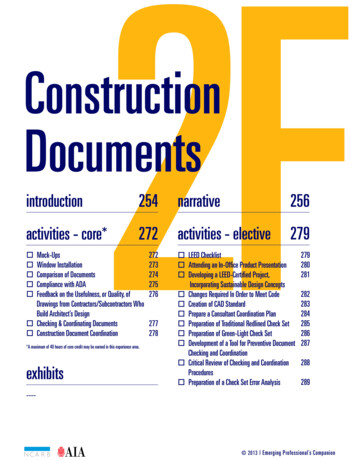
Transcription
Ownership of Documents and Intellectual Property:Are They the Same or How Do They Differ?RLI Design ProfessionalsDesign Professionals Learning EventDPLE 150March 4, 2015
RLI Design Professionals is a Registered Provider with TheAmerican Institute of Architects Continuing EducationSystems. Credit earned on completion of this program will bereported to CES Records for AIA members. Certificates ofCompletion for non-AIA members are available on request.This program is registered with the AIA/CES for continuingprofessional education. As such, it does not include contentthat may be deemed or construed to be an approval orendorsement by the AIA of any material of construction orany method or manner of handling, using, distributing, ordealing in any material or product. Questions related tospecific materials, methods, and services will be addressedat the conclusion of this presentation.
Copyright MaterialsThis presentation is protected by US and InternationalCopyright laws. Reproduction, distribution, display anduse of the presentation without written permission ofthe speakers is prohibited. RLI Design Professionals
Course DescriptionOwners often take the position that because they arepaying for the plans and specifications, they should ownthem, while, design professionals are concerned that thework be paid for and that the plans not be usedimproperly. Further issues relating to ownership and use ofplans arise if the design professional is terminated or leavesthe project before completion. Or, what happens if anemployee leaves the firm? Who owns the documents?In today’s course we will explore the complicated issuesaround ownership of documents and intellectual propertyand how to address these issues with your client.
Learning ObjectivesParticipants will:Learn what it means whenthey transfer ownership ofdocuments and intellectualproperty;Gain an understanding ofhow ownership ofdocuments and ownership ofintellectual property differ;Review examples of contractlanguage that may beproblematic; andConsider contract languagethat may protect them ifthey are terminated from aproject, leave the projectbefore it is completed, or anemployee leaves the firm.
DisclaimerAll provisions in this presentationare furnished solely for educational purposes.Nothing herein is intended as legal advice, nor as ameans of establishing an attorney-client relationship.Laws and regulations may vary considerablyby jurisdiction. Accordingly, you are advised toconsult a knowledgeable attorney beforemaking any contractual modifications.― A Wise Lawyer
Intellectual Property ConcernsThe FederalCopyright ActArchitecturalWorks CopyrightProtection Act
Intellectual Property ConcernsFederal Copyright Act: ExceptionA "work made for hire” includes:(1) work prepared by an employee within thescope of his or her employment; or(2) a work specially ordered or commissioned . . .if the parties expressly agree in a writtenagreement signed by them that the work shallbe considered a work for hire.
Contract Language: Intellectual Property Concerns“Work-for-Hire. To the extent permitted by law,Independent Contractor agrees that theDevelopments shall be considered "work-made-forhire" and Client will be deemed the creator or authorthereof. In the event any or all of the Developmentsdo not qualify as "work-made-for-hire”, thisAgreement shall operate as a full, complete,unconditional and irrevocable assignment to Client ofall right, title and interest in the Developments,including the copyrights thereto.”
Contract Language: Intellectual Property Concerns“Work-for-Hire. To the extent permitted by law,Independent Contractor agrees that theDevelopments shall be considered "work-made-forhire" and Client will be deemed the creator or authorthereof. In the event any or all of the Developments donot qualify as "work-made-for-hire”, this Agreementshall operate as a full, complete, unconditional andirrevocable assignment to Client of all right, title andinterest in the Developments, including the copyrightsthereto.”
Case StudyKunycia v. Melville Realty Company, Inc., 755 F. Supp. 566 (S.D.N.Y. 1990)
Sample Contract Language“The Architect and the Architect’s consultants shall bedeemed the authors and owners of their respectiveInstruments of Service, including the Drawings andSpecifications, and shall retain all common law,statutory and other reserved rights, includingcopyrights. Submission or distribution of Instruments ofService to meet official regulatory requirements or forsimilar purposes in connection with the Project is not tobe construed as publication in derogation of thereserved rights of the Architect and the Architect’sconsultants.”--AIA Document B101-2007, § 7.2
Ownership of DocumentsOwnership ofDocumentsLimited NonExclusiveLicense
Contract Language: Ownership of Documents Concerns“Client will have the right to use for its ownpurposes any ideas, methods, techniques,materials and information provided to orotherwise obtained by Client as a result of thisAgreement, without restriction, liability orobligation; ”
Contract Language: Ownership of Documents Concerns“Client will have the right to use for its ownpurposes any ideas, methods, techniques,materials and information provided to orotherwise obtained by Client as a result of thisAgreement, without restriction, liability orobligation; ”
Case StudyJohnson v. Jones, 149 F.3d 494, 5010502, 47 U.S.P.Q.2d1481, 1998 FED App. 0112P (6th Cir. 1998)
Ownership: Yours, Mine, or Ours?In exchange for the transfer, does the Recipient agree that:PaymentDo the documentsremain the DesignProfessional’sproperty until theDesign Professionalhas received fullpayment for theservices provided,and the project iscompleted?ReuseOwner’s RiskIndemnificationDP’s RightsThe Recipient willThe documents areproject-specific andare not intended for Any reuse by thereuse on otherRecipient withoutprojects?the DesignProfessional’sinvolvement will beat the Recipient’ssole risk?defend, indemnify,and hold the DesignProfessionalharmless from anyclaims broughtagainst them arisingout of the reuse?The DesignProfessional has theright to retain onerecord copy of allproject documentsand to reusestandard details ofthe contractdocuments?
What Does the AIA Say?“Upon execution of this Agreement, the Architect grants to the Owner anonexclusive license to use the Architect’s Instruments of Service solely andexclusively for purposes of constructing, using, maintaining, altering andadding to the Project, provided that the Owner substantially performs itsobligations, including prompt payment of all sums when due, under thisAgreement. The Architect shall obtain similar nonexclusive licenses from theArchitect’s consultants consistent with this Agreement. The license grantedunder this section permits the Owner to authorize the Contractor,Subcontractors, Sub-subcontractors, and material or equipment suppliers, aswell as the Owner’s consultants and separate contractors, to reproduceapplicable portions of the Instruments of Service solely and exclusively foruse in performing services or construction for the Project. If the Architectrightfully terminates this Agreement for cause as provided in Section 9.4, thelicense granted in this Section 7.3 shall terminate.”--AIA Document B101-2007, § 7.3
What Does the AIA Say?“In the event the Owner uses the Instruments of Service withoutretaining the author of the Instruments of Service, the Ownerreleases the Architect and Architect’s consultant(s) from allclaims and causes of action arising from such uses. The Owner,to the extent permitted by law, further agrees to indemnify andhold harmless the Architect and its consultants from all costsand expenses, including the cost of defense, related to claimsand causes of action asserted by any third person or entity to theextent such costs and expenses arise from the Owner’s use ofthe Instruments of Service under this Section 7.3.1.”--AIA Document B101-2007, § 7.3.1
Ownership of DocumentsWhat if you are terminated from the project?PaymentIndemnificationUse ofDocumentsDoes your contract address these considerations?
Case StudyMeisner Brem Corp. v. Mitchell. 313 F. Supp. 2d 13, 2004 DBH 67 (D.N.H.)
Risks for Terminated Design ProfessionalsOwnership and Use of Documents“To the fullest extent permitted by law, the Documents prepared by theDesign Professional, regardless of form, shall remain the property ofthe Design Professional. The Design Professional shall retain allcommon law, statutory and other reserved rights, including, withoutlimitation, the copyrights thereto.”“The Parties agree that at this time, the Design Professional does notrepresent that the Documents are complete, or that they are consistentwith the current conditions that may affect the Project, and makes norepresentations or warranties about the fitness of the Documents forany particular purpose.”
Risks for Terminated Design ProfessionalsOwnership and Use of Documents – License to Use Upon Payment“Upon payment in full for services rendered hereunder, theDesign Professional grants to Owner a nonexclusive licenseto use the Design Professional’s Instruments of Servicesolely and exclusively for purposes of constructing, using,maintaining, altering and adding to the Project. The licensegranted under this section permits the Owner to authorizethe Contractor, Subcontractors, Sub-subcontractors, andmaterial or equipment suppliers, as well as the Owner’sconsultants and separate contractors, to reproduceapplicable portions of the Instruments of Service solely andexclusively for use in performing services or construction forthe Project.”
Risks for Terminated Design ProfessionalsRelease and Indemnification from Owner when Owner wants to useyour documents going forward without you continuing on theproject:“In consideration of the mutual covenants, conditions, and agreements hereincontained and other good and valuable consideration, the receipt and sufficiency ofwhich are hereby acknowledged, the Owner agrees to waive any and all claimsagainst the Design Professional and to defend, indemnify and hold the DesignProfessional harmless from and against any and all claims, losses, liabilities anddamages arising out of or resulting from the use, reuse or alteration of the DesignProfessional’s Documents by the Owner or any other entity or individual. The Ownerwill remove markings on the Documents that would be sufficient to identify theDesign Professional as the author of the Documents.”
Ownership of DocumentsWhat if you are replacing a design professional on the project?IndemnificationUse of DocumentsDoes your contract address these considerations?
Use of Documents: New Design ProfessionalEvaluate language such as:“In consideration of the mutual covenants, conditions, and agreements hereincontained and other good and valuable consideration, the receipt andsufficiency of which are hereby acknowledged, the Owner agrees:1) the Owner has permission from [Other Design Professional] that Owner canforward plans and specifications and any and all Instruments of Servicescreated by [Other Design Professional] to the Design Professional for theDesign Professional’s use in the preparation of the Design Professional’s plansand specifications; and,2) Owner agrees to waive any and all claims against the Design Professionaland to defend, indemnify and hold the Design Professional harmless fromand against any and all claims, losses, liabilities and damages arising out of orresulting from the services performed by the [Other Design Professional].”
Transmission and Ownership of Digital DataOwnership and UseDoes not conveyownership rightsLimited right to useor modify dataLimited ability totransmit
What Does the AIA Say?“The Architect and the Owner warrant that in transmittingInstruments of Service, or any other information, thetransmitting party is the copyright owner of such information orhas permission from the copyright owner to transmit suchinformation for its use on the Project. If the Owner and Architectintend to transmit Instruments of Service or any otherinformation or documentation in digital form, they shallendeavor to establish necessary protocols governing suchtransmissions.”--AIA Document B101-2007, § 7.1
Transmission and Ownership of Digital DataBy transmitting Digital Data, thetransmitting Party does not convey any ownershipright in the Digital Data or in the softwareused to generate the Digital Data.Unless otherwise granted in a separate license,the receiving Party’s right to use, modify, or furthertransmit Digital Data is specifically limited todesigning, constructing, using, maintaining,altering and adding to the Project Adapted from the AIA E203-2013, § 2.3
What Does the AIA Say?“To the fullest extent permitted by law, the Receiving Partyshall indemnify and defendthe Transmitting Party from and againstall claims arising from or related tothe Receiving Party’s modification to,or unlicensed use of, the Digital Data.”--AIA Document C106-2013, § 2.5
This concludes The American Institute of ArchitectsContinuing Education Systems ProgramLaurel Tenuto, Client Risk Management CoordinatorLaurel.Tenuto@rlicorp.comMarie Bernier, Senior Risk Management ConsultantMarie.Bernier@rlicorp.com
hire" and Client will be deemed the creator or author thereof. In the event any or all of the Developments do not qualify as "work-made-for-hire”, this Agreement shall operate as a full, complete, unconditional and irrevocable assignment to Client of all right, title and interes
